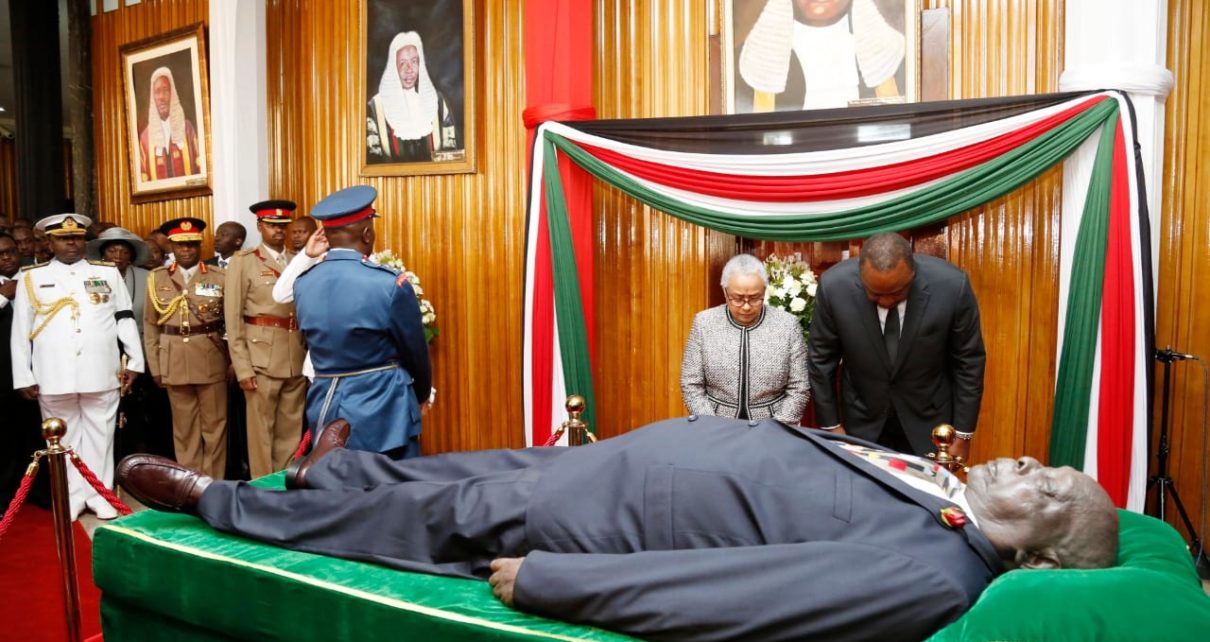Those scrambling to view Moi’s body are motivated by their only chance of entering Parliament
By Undercover Reporter
@Undercover KE
They have been jostling, pushing, shoving. Others jump queues, effects of impatience, the baking sun. The purpose: A second to file past a dead body. Indeed, Kenyans from all walks and runs of life have been making a beeline at Parliament buildings to view the body of the late retired President Daniel arap Moi. His remains have been lying in state for three days to February 10 to allow Kenyans show their final respect.
Think about. Why do people view dead bodies?
It is curious really, the custom of viewing dead bodies including strangers one hardly knew. In Western Kenya, eyes are often turned into taps, wailing, rolling, cursing as a mourner ambles towards a coffin opened to allow peeping at the face of the deceased. One look, just one look, and decibels are notched higher, the strain of dirges.
People in Central Kenya, who are indifferent to funerals from their pre-colonial tradition of disposing the dead in forests to be devoured by hyenas, long stopped the viewing of bodies at the burial place of the deceased. Instead, they restricted crying at the sight of the deceased to the viewing area at the mortuary or funeral home.
Kenyans scrambling to view Moi’s body might be motivated by several factors: It is their only chance of entering parliament and after all, they never saw Moi at close quarters.
Reaffirming the reality that death is a “universal, natural, persistent, inescapable, unavoidable, and undeniable fact of life”
While the magnitude of a state funeral, the larger-than-life persona of Moi besides the aura of power that goes with it, surveyed closely, people view bodies for more than paying last respects. How is staring at someone who is ‘biting cotton’ constitute last respect?
Well, some quarters argue that finding time and money to attend burials is one aspect of final respect of which viewing a dead body is part. Imagine the chance to see the departed one last time and no one takes it?
Sociologists inform us on good authority that viewing dead bodies before burial is not only steeped in tradition of most communities whose cultural practices informs their world view about dying with viewing a dead body providing a mental curtain but reaffirming the reality that death is a “universal, natural, persistent, inescapable, unavoidable, and undeniable fact of life.”
Then there is religion which has been incorporated in funeral rituals to provide “meaning and answers to the problems of uncertainty, powerlessness, and scarcity that death creates.”
But culture has conditioned Africans not to face the reality of their mortality. This explains the reluctance of Kenyans to write wills over 50 years after independence. Discouraging people to contemplate their ends has seen increased cost of burials as more people avoid taking life insurance policies.
Viewing a dead body thus only confirms that which they postpone confronting until the next burial. Until Christianity brought the bible and new ways of worship, those who died became ancestors, the ‘living dead’ and the reason in some communities the dead are not far from the living room. Viewing a dead body is one part separation from them since they won’t be buried far, but you won’t manage to seem them in their underground conditions.
Traditional, religious and cultural reasons aside, there are also the more powerful psychological reasons.
Like the psychos who attend burial of strangers, crying more than the bereaved. A variation of this psycho is the other who feels lucky they are not the ones being planted six feet under. These is the breed you have heard goes on long road trips for burials, but in reality, is a drinking spree to celebrate life of dear departed, but deep inside, it’s the feeling they have another half-life, more chances to go.
Then there are psychological underpinnings. Viewing brings mental closure that death is it.
Others are long lost relatives one never met, but here they are, viewing you one last time “until we meet again.” They want to preserve their memory of you, eyes closed, body pumped with formalin.
If you had enemies, then viewing provides them with a chance to confirm that the bastard is dead, long live the bastard. This is common among criminals when a crime buster police is felled by one of their own.
Viewing dead bodies is out of curiosity which death occasions, but for the majority, viewing is spurred by mob psychology, group think, that herd mentality not to be left behind, to do something everyone is doing…including shedding buckets of tears while blowing noses into dump handkerchiefs.

